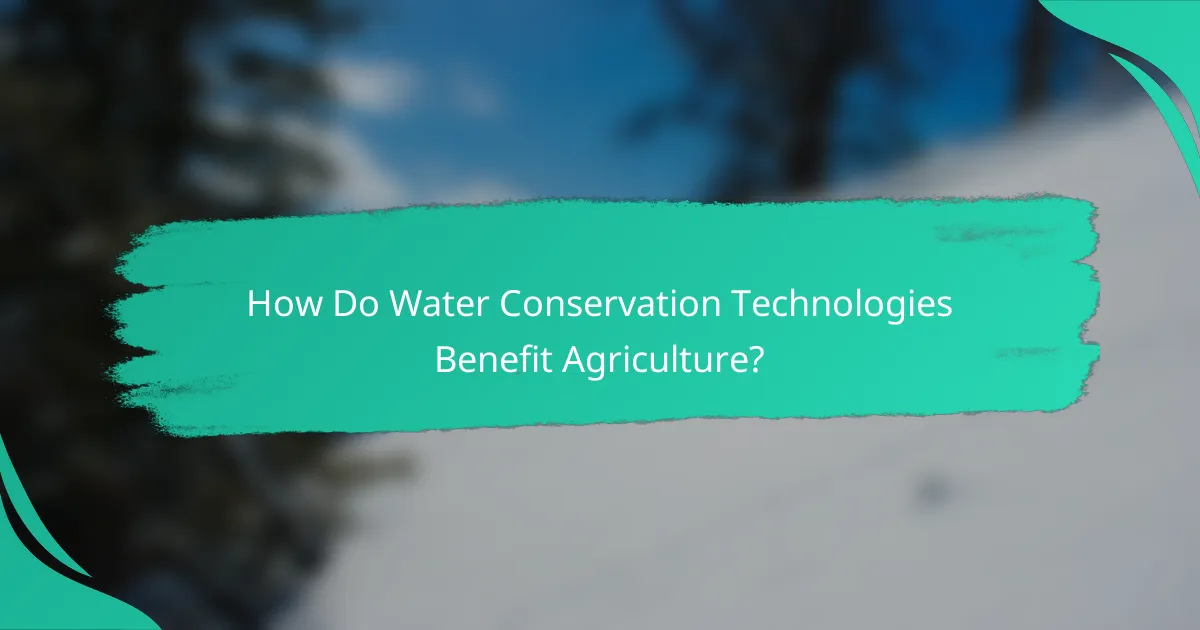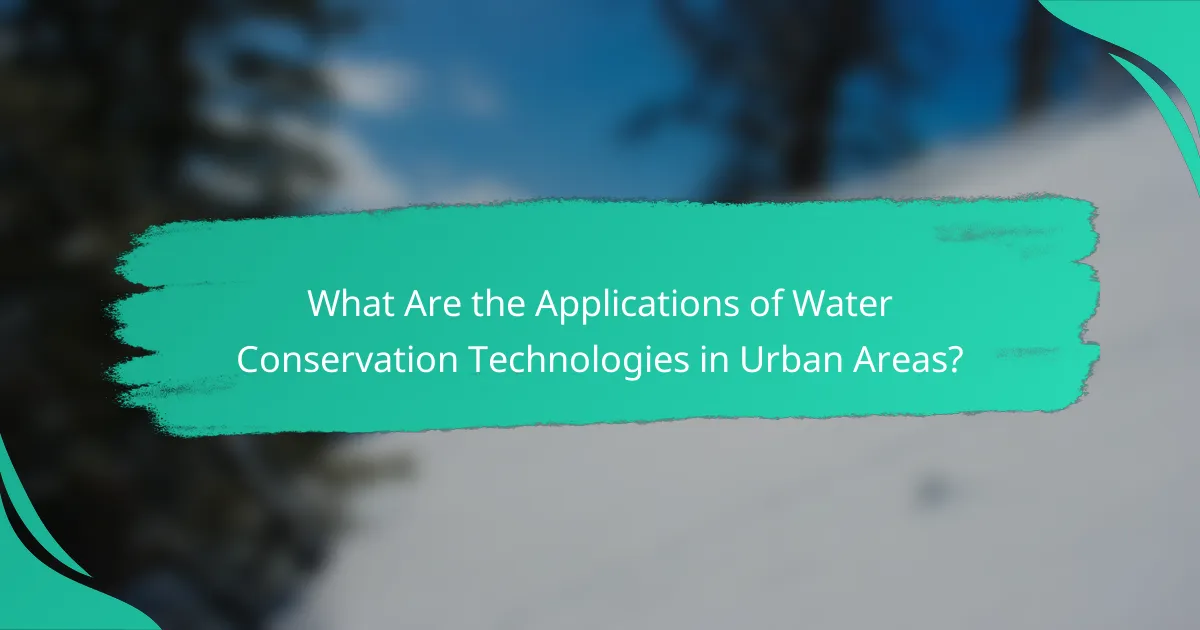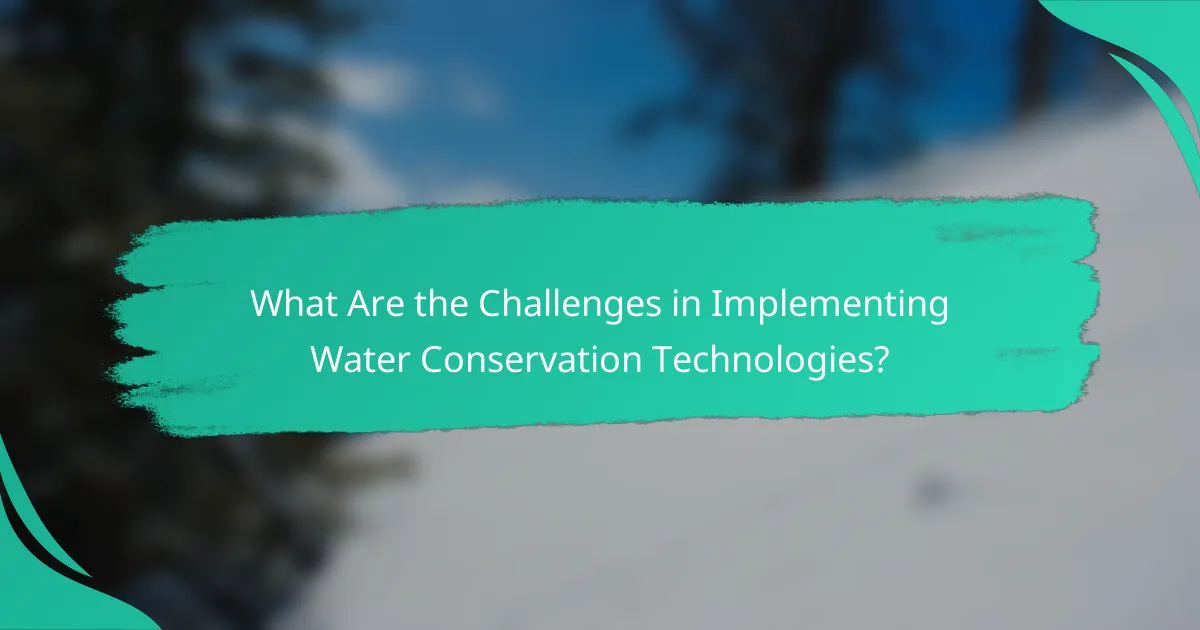Water conservation technologies play a vital role in reducing water usage while maintaining efficiency across various sectors. By optimizing water use, these methods not only lower utility bills but also enhance agricultural productivity and promote sustainable practices in urban environments. Implementing these technologies is essential for ensuring a sustainable water supply and fostering responsible water management.

What Are the Most Effective Water Conservation Technologies?
The most effective water conservation technologies include methods that significantly reduce water usage while maintaining efficiency. These technologies not only help in conserving water but also contribute to lowering utility bills and promoting sustainable practices.
Drip Irrigation Systems
Drip irrigation systems deliver water directly to the roots of plants through a network of tubing and emitters. This targeted approach minimizes evaporation and runoff, making it highly efficient, especially in agriculture and landscaping.
When implementing drip irrigation, consider soil type and plant needs to optimize water delivery. Regular maintenance is essential to prevent clogging and ensure system longevity.
Rainwater Harvesting
Rainwater harvesting involves collecting and storing rainwater from rooftops or other surfaces for later use. This method can significantly reduce dependency on municipal water supplies and is particularly beneficial in areas with seasonal rainfall.
To set up a rainwater harvesting system, install gutters and downspouts leading to a storage tank. Ensure compliance with local regulations regarding water quality and usage to maximize benefits.
Greywater Recycling
Greywater recycling systems treat and reuse wastewater from sinks, showers, and washing machines for irrigation or toilet flushing. This practice can reduce overall water consumption by up to 50% in households.
When considering greywater systems, ensure proper filtration and treatment to meet health standards. Check local codes, as regulations may dictate how greywater can be used.
Smart Irrigation Controllers
Smart irrigation controllers use weather data and soil moisture levels to optimize watering schedules. These devices adjust the amount of water applied based on real-time conditions, preventing overwatering and conserving resources.
Investing in a smart controller can lead to savings of 20-50% on water bills. Look for models compatible with local climate data and consider integrating them with existing irrigation systems for best results.
Water-efficient Fixtures
Water-efficient fixtures, such as low-flow faucets, showerheads, and toilets, significantly reduce water usage without sacrificing performance. These fixtures can cut water consumption by 30% or more compared to standard models.
When upgrading fixtures, look for products labeled with the WaterSense label, which indicates they meet efficiency criteria set by the EPA. Regularly check for leaks and maintain fixtures to ensure optimal performance.

How Do Water Conservation Technologies Benefit Agriculture?
Water conservation technologies significantly enhance agricultural productivity by optimizing water use, leading to healthier crops and sustainable farming practices. These technologies not only improve crop yields but also reduce the overall water consumption, making farming more efficient and cost-effective.
Increased Crop Yields
Implementing water conservation technologies can lead to increased crop yields by ensuring that plants receive the right amount of water at the right time. Techniques such as drip irrigation deliver water directly to the roots, minimizing evaporation and runoff. Farmers using these methods often see yield improvements of 20-50% compared to traditional irrigation systems.
Additionally, precision agriculture tools help monitor soil moisture levels, allowing farmers to apply water only when necessary. This targeted approach not only boosts productivity but also promotes healthier plants that are more resilient to pests and diseases.
Reduced Water Usage
Water conservation technologies significantly reduce water usage in agriculture by employing efficient irrigation systems and moisture management practices. Drip and sprinkler irrigation systems can cut water use by 30-70% compared to flood irrigation. This reduction is crucial in areas facing water scarcity or where water resources are heavily regulated.
Farmers can also implement rainwater harvesting systems to collect and store rainwater for irrigation, further decreasing reliance on groundwater or municipal water supplies. These practices not only conserve water but also help maintain local ecosystems by reducing the demand on natural water sources.
Cost Savings for Farmers
By adopting water conservation technologies, farmers can achieve significant cost savings over time. Reduced water usage translates directly into lower water bills, which can be particularly beneficial in regions with high water costs. Moreover, improved crop yields can lead to increased revenue, offsetting the initial investment in technology.
Farmers should also consider the long-term savings associated with reduced energy costs for pumping water and the potential for lower fertilizer expenses due to better nutrient management. Overall, the financial benefits of these technologies can enhance farm profitability and sustainability.

What Are the Applications of Water Conservation Technologies in Urban Areas?
Water conservation technologies in urban areas focus on efficient water use and management to reduce waste and ensure sustainable supply. These applications include stormwater management, residential water conservation, and public awareness campaigns, each playing a crucial role in promoting water efficiency.
Stormwater Management
Stormwater management involves techniques that capture and utilize rainwater runoff, reducing flooding and improving water quality. Common methods include green roofs, permeable pavements, and rain gardens, which allow water to infiltrate the ground rather than overwhelming drainage systems.
Implementing stormwater management can significantly decrease the volume of water entering sewer systems, thus lowering treatment costs. Urban planners should consider local regulations and environmental conditions when designing these systems to maximize their effectiveness.
Residential Water Conservation
Residential water conservation technologies aim to reduce water usage in homes through efficient fixtures and appliances. Low-flow showerheads, dual-flush toilets, and smart irrigation systems can cut household water consumption by 20-50% without sacrificing comfort.
Homeowners should evaluate their current water usage and consider retrofitting older fixtures with modern, water-saving options. Additionally, installing rain barrels can provide an alternative water source for gardening, further enhancing conservation efforts.
Public Awareness Campaigns
Public awareness campaigns educate communities about the importance of water conservation and promote sustainable practices. These initiatives can include workshops, informational brochures, and social media outreach, aiming to change behaviors and attitudes towards water use.
Effective campaigns often highlight simple actions, such as fixing leaks, using water-efficient appliances, and practicing mindful consumption. Collaborating with local governments and organizations can amplify these efforts, ensuring broader community engagement and impact.

What Criteria Should Be Considered When Choosing Water Conservation Technologies?
When selecting water conservation technologies, consider factors such as cost-effectiveness, scalability, and maintenance requirements. These criteria help ensure that the chosen solutions are not only financially viable but also practical and sustainable in the long term.
Cost-effectiveness
Cost-effectiveness is a critical factor when evaluating water conservation technologies. It involves analyzing both the initial investment and the long-term savings on water bills. For example, technologies like rainwater harvesting systems may have higher upfront costs but can lead to significant savings over time.
To determine cost-effectiveness, calculate the return on investment (ROI) by comparing the costs of implementation against the expected savings. Look for technologies that offer a payback period of a few years, which is generally considered favorable.
Scalability
Scalability refers to the ability of a water conservation technology to grow or adapt to changing needs. This is particularly important for businesses or communities that may expand in the future. For instance, a small-scale drip irrigation system can be easily scaled up to accommodate larger agricultural areas.
When assessing scalability, consider whether the technology can be integrated with existing systems and whether it can handle increased demand without significant modifications. Solutions that offer modular components are often more adaptable.
Maintenance Requirements
Maintenance requirements are essential to consider, as they impact the long-term viability of water conservation technologies. Some systems may require regular inspections, cleaning, or part replacements, which can incur additional costs. For example, greywater recycling systems often need periodic maintenance to ensure proper filtration and functionality.
Evaluate the maintenance needs of each technology and factor these into your decision-making process. Opt for solutions that offer low maintenance or provide warranties and support services to minimize future hassles.

What Are the Challenges in Implementing Water Conservation Technologies?
Implementing water conservation technologies faces several challenges, including financial constraints, technical knowledge gaps, and regulatory hurdles. These obstacles can hinder the adoption of effective solutions designed to reduce water usage and improve efficiency.
Initial Investment Costs
Initial investment costs for water conservation technologies can be significant, often deterring organizations and individuals from adopting these solutions. Depending on the technology, costs can range from a few hundred to several thousand dollars, influenced by factors such as installation complexity and system size.
For example, installing a rainwater harvesting system may require an upfront investment of around $1,000 to $5,000, while more advanced systems like greywater recycling can exceed $10,000. It’s essential to evaluate the long-term savings on water bills against these initial costs to determine feasibility.
To mitigate financial barriers, consider exploring government incentives, grants, or financing options that support water conservation initiatives. Many regions offer rebates or tax credits for implementing such technologies, making them more accessible.
